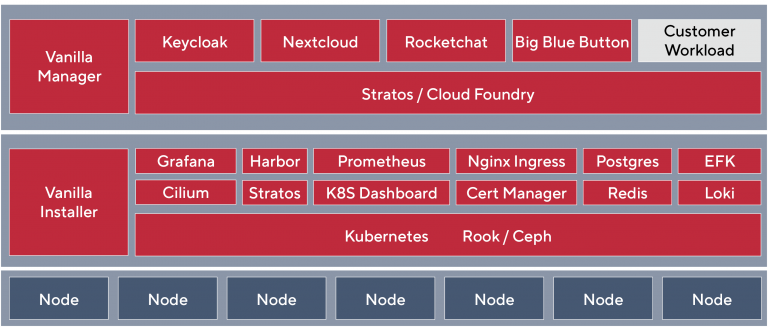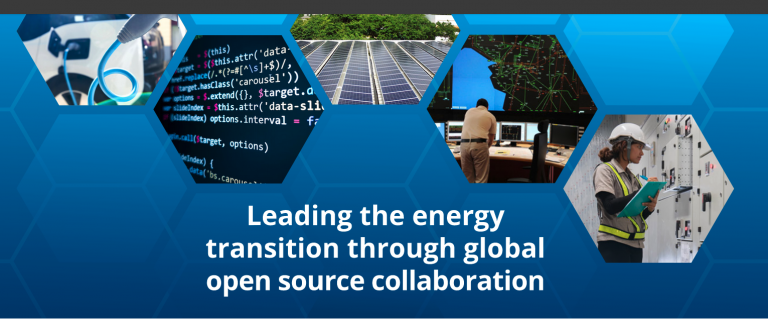
Open Source and Sustainability
by Friederike Zelke, initially published by The Cloud Report. The article examines the link between open-source software and sustainability, illustrating how open-source practices support environmental goals through innovation and collaboration. It argues for the broader, beneficial impacts of open-source beyond just cost-efficiency.
– does it compute?
When thinking about open source and sustainability, one of the first things that comes to mind is that they are currently very much Zeitgeist. But what about them in combination? Does it make sense to use them as a pair? And is there perhaps a wider correlation between them, apart from software and infrastructure? Let’s find out…

Sustainability in software and infrastructure is often understood as lowering costs, since – obviously – spending less money is more sustainable than spending more of it. With this in mind open source software appears to be a perfect enabler for a more sustainable approach, since it is considered to be free. Or is it?
Is open source free?
Don’t be fooled: open source is not free per se. The term “open source” refers to the fact, that the source code of a given project (and most often, only a part of it), is made available to the public for review and auditing purposes.
This does not imply the software being free to use, or a potential user being allowed to modify and use the software freely. As an example: Microsoft is amongst the biggest contributors to open source software, and quite heavily uses it in its products. But Microsoft’s products are not free, and neither is it permitted to freely modify and use their software.
It all depends on the business model, and the license being granted by the author.
Open source vs. crippled source
Since it is true that most software being published as open source is given a relatively open and permissive license, such as Apache 2.0 license, many if not most of the software is nonetheless not usable per se, since most of the licenses do not demand the software as a whole – including installation scripts, additional components, and internal tools – to be made available.
This quite often leads to situations where a potential user of a software would not be able to use it at all, since important components or aspects of given software would be missing or would only be made available to paying customers under special licensing.
This habit of leaving out important aspects of an open sourced product is called “open core” model, and is very often utilized by larger software vendors, such as Red Hat or SUSE, since it allows them to position themselves as “open source vendors” without actually being that open.
Access to products is very often granted based on yearly fees. One is only allowed to install time or feature limited trial-versions of a product, while a continuous usage would imply either buying a license or signing up for a so-called support subscription. While it is true that such software is often made available as community editions, again, these editions are mostly feature limited.
This can only lead to one conclusion: open source does not necessarily imply a cost-saving approach. Or, to put it differently, open source is not per se sustainable.
Bringing sustainability to open source
To achieve sustainability with an open source approach, only software being completely published under a permissive license (Apache 2.0 or similar), and not being made available as open core solution, should be considered. This, in fact, leaves out most of the larger and / or commercially oriented software vendors, but it is crucial for financial and business sustainability. One of the projects being completely built upon these principles is VanillaStack, a Kubernetes distribution which is provided with everything one needs to set up and run a Kubernetes cluster on literally any platform, with the idea of taking away complexity and vendor lock.

Fig. 1: a complete open source stack to set up and run a Kubernetes cluster
Financial sustainability
Financial sustainability is achieved by not having to pay for licensing or enforced subscription costs. Financially sustainable software does not cost anything and is available without limitations. The business model of organizations going that route depends on providing commercial support and / or additional services, such as managed services or hosting services. When software does not imply a cost-factor per se, but is maintained by a vendor, it can be considered to be financially sustainable from a user’s perspective. Obviously, money needs to be spent for support and or additional services, allowing the vendor to continue its operations.
Business sustainability
Business sustainability is achieved by open source only when it is – again – not just some sort of an open cored model. A complete open sourced product allows to achieve several business-critical aspects:
- More security, since the whole code is available for audits and security inspections
- Less vendor lock, since the whole product is available to the user, not some form of locked-down base version
- More knowledge for teams working with the product, since everything is laid out to them
- Lower costs of ownership, since the product is typically used by more customers, which creates bigger audience and community
These factors all contribute to business sustainability, allowing customers to work over a longer period of time deeper and more reliably with their software stacks. As a result, true open source is way more sustainable then using crippled open source or proprietary solutions.
Sustainability and open source on a more fundamental level
Open source is very often driven by communities of passionate people. Many of them start projects and work on them in their spare time. Therefore, it should be of no surprise, that the ideas of an open source movement have spread far beyond the scope of “just” software or infrastructural solutions: Currently, projects around open sourced processors, computers, printers, vehicles and bikes, medical equipment, and even houses, are in active development or already on the market. All of these projects aim to get rid of proprietary knowledge and target a more sustainable approach to things: With community driven development, with making plans available, with an inclusive approach to participation, they allow for spreading knowledge, for incorporating experiences, and for preventing from built-in and purposefully implemented obsolescence, thus leading to more sustainability and less waste.
Open source and climate change
Since the open source culture is centred around community and collaboration, it should be of no wonder, that open source projects also try to address the issues of climate change and ecological disaster.
Searching for “open source climate change” reveals a long list of open source projects. A good overview of such projects delivers the website Open Sustainable Technology, which groups these projects into categories, provides links and explains their purpose.
Also, large open source foundations, such as The Linux Foundation, are hosting and supporting open source sustainable projects. Take LF Energy, whose goal is to support and provide open source solutions focused on the power systems sector: The projects of this foundation provide a unified approach allowing to utilize a neutrally developed and maintained development environment and toolboxes for this sector. The Cloud Report had a great interview with LF Energy’s founder and executive director Shuli Goodman.
The approach of such projects and foundations is a very sustainable one on its own, since it prevents single player in the markets from having to develop software components and platforms themselves, allowing them to focus on bringing them into production, utilizing them, and gaining knowledge on a faster scale.
This knowledge then can be used to speed up decarbonization, contributing to the ideas of sustainable software, sustainable software ecosystems, and to a more sustainable future overall.

Fig. 2: The LF Energy brings together open source projects with an energy saving and sustainable approach.
Summary
To sum this up: open source and sustainability belong together. On many levels – reaching from avoiding vendor locks, spreading knowledge, having control, ensuring security, preventing from obsolescence, to provide support for fighting climate change. When done right, even commercial aspects and market positions of companies cantered around open source benefit from it.
Both aspects add to each other. The spirit of independently developed and maintained projects, which allow their users to focus on usage and adoption, rather than to reinventing the wheel over and over again, directly leads to more sustainability.
To put it differently: true sustainability in business, in ecology, in infrastructures, can only be achieved with open source, since it enforces sharing of ideas, open discussions and diversity on pretty much all levels.
Therefore: yes, it does compute! And it should be understood as one of the primary models to software and platform development, to infrastructure, and to a more sustainable and inviting future.